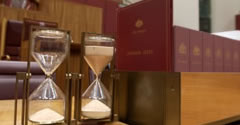101 Taking of divisions
-
Before a division is taken the Clerk shall ring the division bells for 4 minutes.
-
The doors shall be closed and locked as soon after the bells cease ringing as the President directs, and then no senator shall enter or leave the chamber until after the division.
-
When successive divisions are taken, and there is no debate after the first division, the bells for each ensuing division shall be rung for one minute only.
-
When the doors have been locked, and senators are in their places, the President shall state the question to the Senate, and then direct the “ayes” to proceed to the right of the chair, and the “noes” to the left, and shall appoint one teller for each side.
-
Every senator present when the question is stated shall vote, except the President, or the Chairman of Committees in the chair of a committee, for whom voting shall be optional.
-
When a division has been called for, senators shall take seats on the side of the chamber on which they intend to vote, and shall not move from those seats after tellers have been appointed until the result of the division has been declared.
Amendment history
Adopted: 19 August 1903 as SOs 165, 166, 167, 168, 169 (corresponding to paragraphs (1), (2), (4), (5) and (6))
Amended:
- [11 February 1975, J.497 (sessional order adopted increasing the time for ringing of the bells from two to three minutes and providing for one minute bells on successive divisions)]
- 20 August 1975, J.860 (and see 19 August 1975, J.852–53) (time for ringing of the bells increased from two to three minutes; paragraph (3) adopted as SO 174A after a six month trial as a sessional order)
- [1 June 1988, J.802 (ringing of bells extended to 4 minutes in new Parliament House by sessional order)]
1989 revision: Old SOs 173, 174, 174A, 175, 176 and 177 combined into one, structured as six paragraphs and renumbered as SO 101 ; 1988 sessional order incorporated increasing the time for ringing of the bells to four minutes; language modernised and expression streamlined
Commentary
Of this group of practical rules for the conduct of divisions, only paragraph (2) was the subject of any debate in 1903 because, in its original formulation, Senator Higgs (ALP, Qld) thought that it gave discretion to a President to delay locking the doors and proceeding to a division. Although this had not occurred in practice in the Senate, Senator Higgs recommended the removal of any doubt. His bid failed and, apart from some modernisation of language, paragraph (2) has remained as agreed to in 1903.
In contrast, paragraph (1) has undergone significant pruning as well as being affected by physical factors inherent in the various buildings occupied by the Senate since 1901. Until 1989, it contained references to a sand-glass kept on the Table for the purpose of timing divisions. The Clerk was responsible for turning the sand-glass and the time was taken to have elapsed when the sand-glass so indicated. References to this antique but reliable technology were removed in the course of the 1989 revision to free the principle from reliance on any particular technology. Although sand-glasses continue to be used as the primary means of timing the division or quorum bells, they are now used in conjunction with the digital speech timer. An advantage of the latter is that it enables a time signal to be broadcast on the House Monitoring Service which shows senators how much time remains for them to reach the chamber. In practice, the Chair takes whichever methodology expires last as a signal to call for the doors to be locked.

Hour glasses, backed up by digital timers, are used to measure the period of time either four minutes or one minute for which the bells ring before a division (Photo courtesy of AUSPIC)
Originally set at two minutes, in 1975 the time for the ringing of the bells was increased to three minutes in response to senators not having enough time to get to the chamber from committee rooms in a new extension to Old Parliament House. Senators felt that they “should have been in training for the Olympic Games” in order to get to the chamber in time for a division.[1] In recommending the change, the Standing Orders Committee also offered a quid pro quo by suggesting that where successive divisions were held without intervening debate, the bells should ring for only one minute, to save time. Both recommendations were adopted as sessional orders on 11 February 1975 and permanently on 19 August 1975.[2]
In 1988, a sessional order was adopted for operation in the new Parliament House that increased the time for the ringing of the bells to four minutes.[3] The change was incorporated in the revised standing orders and therefore became permanent on their adoption on 29 November 1989, with effect from the first sitting day in 1990.
When the bells are rung the sound can be heard in most of the rooms and corridors throughout Parliament House and in the courtyards. Red or green lights (depending on which House is dividing) flash on all clocks and at some external points. If both Houses are dividing at once, a second, pulsing ringing sound is heard. A caption broadcast on the House Monitoring Service indicates whether the bells are ringing for a division or for a quorum.
Once the doors have been locked and the question restated tellers are appointed for the “Ayes” and “Noes” as follows:
CHAIR: Lock the doors!
The question is that …[here state the question]
The Ayes will pass to the right of the Chair, the Noes to the left.
I appoint Senator … teller for the Ayes and Senator … teller for the Noes.

A division in the Senate (Photo courtesy of AUSPIC)

A division known as a 'Mickey' where the major parties combine to vote against a minor party (Photo courtesy of AUSPIC)
It is usual for party whips to be appointed as tellers, but any senator can be appointed. In the early hours of the morning of 14 November 1918, President Givens appointed Senator Needham (ALP, WA) as teller for the Noes but the senator refused to “tell”. The President advised the senator that to refuse to tell meant that he was disobeying a rule of the Senate. He indicated that he had no desire to take any action which would cause friction but thought that the senator “ought to respect a rule of the Senate sufficiently to carry out the duties which may be imposed upon him”. The senator still refused to tell and the President appointed another senator in his place.[4]
Paragraph (4), as originally drafted, provided for the appointment of one teller “for each party”. To avoid confusion in an increasingly multi-party chamber, this was changed in the 1989 revision to “one teller for each side”, reflecting the long-standing practice of the Senate. Occasionally, the suggestion has arisen that there might be circumstances in which it would be useful for more than one teller to be appointed; for example, in relation to so-called conscience votes where inexperienced tellers might be appointed or experienced tellers might have difficulty with unfamiliar partnerships of senators. Such a course of action could not be sanctioned by any presidential discretion but would require authorisation by the Senate. It has not proved necessary in any of the numerous conscience votes that have occurred in recent years, particularly on a range of social legislation initiated by private senators.
Under SO 101 (5) the President in the Senate and the Chair of Committees in the chair of the committee of the whole (and in practice, any senator who occupies the chair at the time of a division) are exempted from the rule that a senator who is present in the chamber must vote. The rationale for this exception is that the senator in the chair cannot avoid voting by leaving the chamber as can other senators. In practice, the President and other senators in the chair normally vote in a division. They do so by indicating whether they are voting with the Ayes or the Noes (see SO 99(2)).
Senators can cross the floor to the other side until the appointment of the tellers. Once tellers have been appointed senators must retain their seats until the result of the division is declared (SO 101 (6)). Unlike the rules in paragraphs (1), (2), (4) and (5) which were taken directly from the South Australian standing orders, paragraph (6) was new, although the Standing Orders Committee noted that it was the practice in most of the States.[5] In 1908 the Chairman of Committees ordered that a senator’s vote be recorded with the “Ayes” as he had crossed the floor and voted with the “Noes” after the tellers had been appointed.[6]
There has evolved in Senate argot a term for divisions in which the major parties combine to vote against a minor party, informally referred to as a “mickey mouse” division or, more simply, a “mickey”. Although it is a widely used term in practice, there are relatively few occurrences of it on the
Hansard record.
[7] It may have had its origins in pejorative references by Senator Walsh (ALP, WA) to the Australian Democrats as a “mickey mouse party”.
[8] As explained by Senator Ray (ALP, Vic), in connection with a particular incident in 1995, the practice of the major party whips is to send members of their own parties out of the chamber if the division is a “mickey”, to enable the count to occur more expeditiously. However, problems can ensue if a “mickey” is followed immediately (with no intervening debate) by a “real” division and, in accordance with paragraph (3), the bells are rung for only one minute. This may leave insufficient time for senators who have left the chamber for the previous division to return for a division in which their votes will be vital.
[9] Where it is expected that successive divisions may occur, it is common nowadays for the Chair to warn senators to remain in the chamber. Chairs have also on occasion ordered the bells to be rung for four minutes for a successive division for the sake of avoiding confusion if the circumstances appear to warrant it.